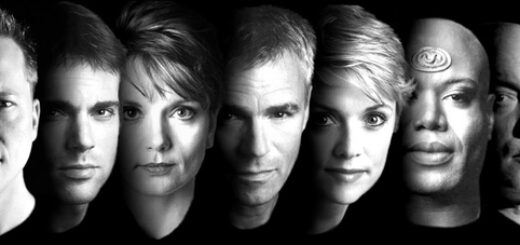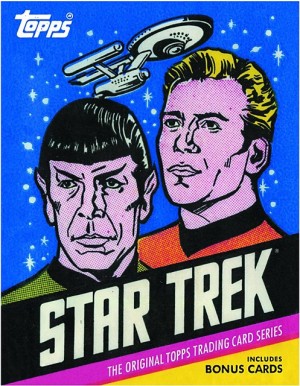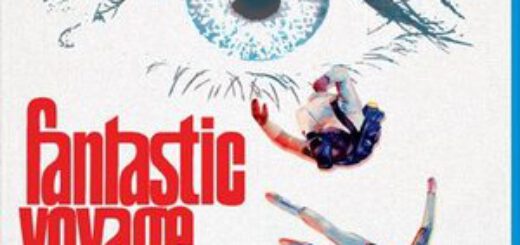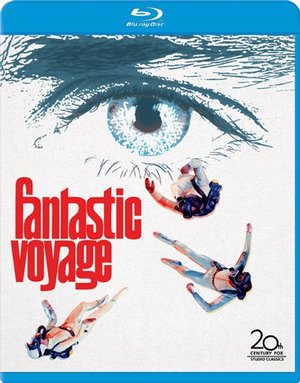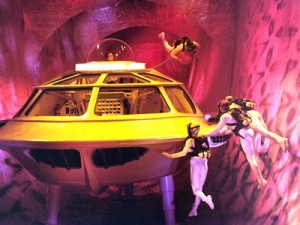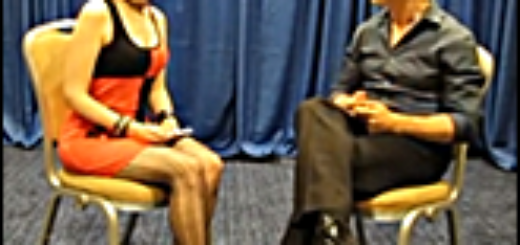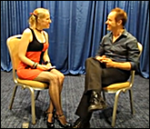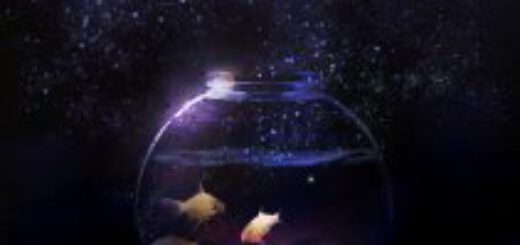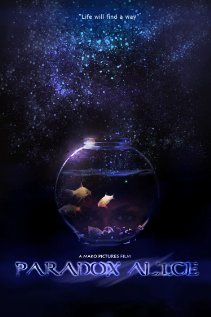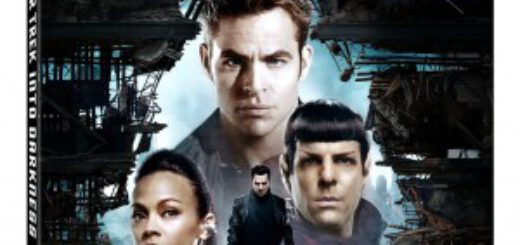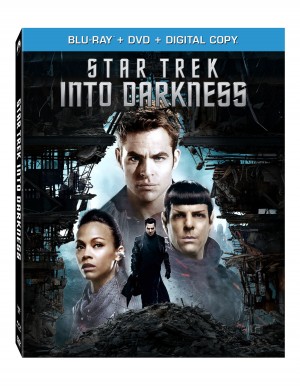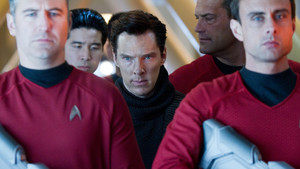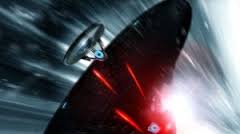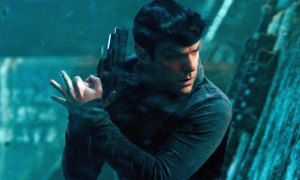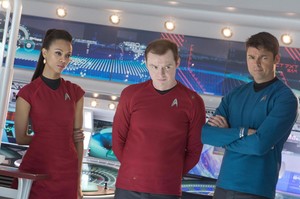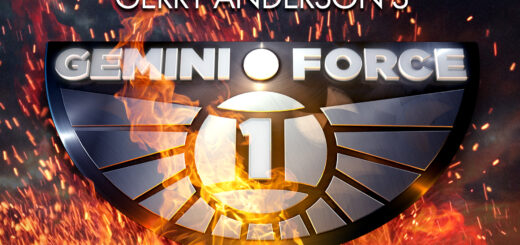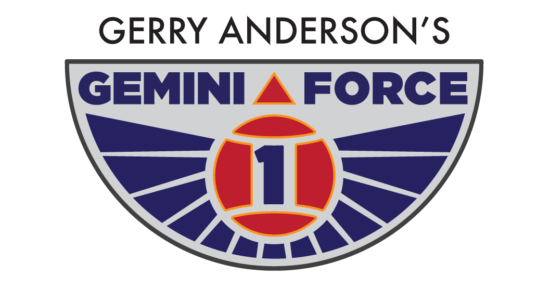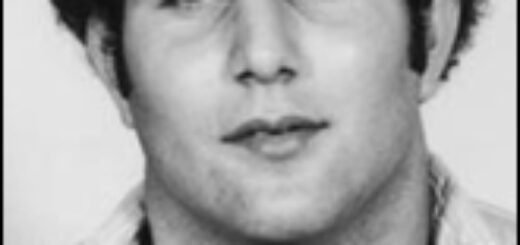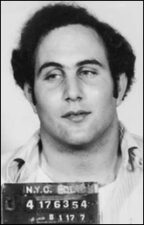Emily S. Whitten: The Almost Human Interviews
 Almost Human, J. H. Wyman’s new science fiction crime drama which is being produced by J.J. Abrams, premiered in two parts on Sunday and Monday on FOX. The series centers around the Los Angeles Police Department, where a detective who dislikes robots is partnered with an android capable of human emotion – a very I, Robot-esque premise with the potential to result in an interesting dynamic.
Almost Human, J. H. Wyman’s new science fiction crime drama which is being produced by J.J. Abrams, premiered in two parts on Sunday and Monday on FOX. The series centers around the Los Angeles Police Department, where a detective who dislikes robots is partnered with an android capable of human emotion – a very I, Robot-esque premise with the potential to result in an interesting dynamic.
I can’t speak about the premiere, not having seen it as yet. But I did sit down and discuss the show with Karl Urban, Michael Ealy, Minka Kelly, Lili Taylor, and Naren Shankar while in San Diego this summer. Read on to see what they had to say about the pilot and the upcoming season!
Karl Urban (John Kennex)
What drew you to this project, and what are your thoughts on the concept and the character?
What drew me was primarily the script. I read the script and I was drawn to the character of John Kennex – a character who’s been in a coma for two years; who wakes up to find that he has a completely robotic leg, that he is responsible for a massive loss of life within his team, and is pushed into the front line of trying to protect and serve humanity. I found that infinitely interesting. A character who is searching for himself, and finds answers in the most unlikely source, which is his synthetic partner. He’s a character who has an aversion to technology and he’s partnered up with a robot, and ironically, the robot is almost more human than humans.
Character and story aside, it was the opportunity to work with Joel Wyman, who I’m a huge fan of. I loved Fringe. It was a really smart show. It wasn’t a stereotypical dumbed-down show. So I knew going into this that the stories were going to be smart; that we’re not going to talk down to an audience. And then obviously, it was my continuing relationship with J.J. Abrams, who really drew me into the project. I wasn’t looking to do television; but once I started looking at all of the elements involved, I thought, “How can I turn this down? This could be really, really cool.”
How has the experience been different, between movies and TV?
So far, the process is fundamentally the same; and if you’ve seen the pilot, you only have to look at that to be blown away by the production elements involved. It looks and feels like a movie, and I feel that it’s going to be really fun to explore the narrative of a character over a season, instead of just two hours, where things are condensed. So I’m excited; I’m looking forward to it.
What do you hope that John learns from Dorian over the course of the show?
It’s my hope that Dorian kind of puts John in touch with himself, with his humanity. In the best world, they learn from each other; because in a way, they’re both searching for what it is to be human. John does not remember vast tracts of his life. He is a character who has a lot of pain; of bitterness; of anger; of torment; of guilt; of frustration – all these emotions, this baggage that he has; and I think consequently, he’s quite closed off. And I think that Michael Ealy’s character, Dorian, is a wonderful mechanism for opening him up a bit, softening him up a bit over time. At the point where we discover John in this pilot – John’s not John yet. He’s just coming off a really heavy deal. I’m really thrilled and excited to see where we go from here.
Doing a movie, you know the whole story going into it. What do you think about doing a TV show, where you might not know where things are going?
I think it’s exciting. It’s just like life – we don’t know what’s just around the corner. And I certainly am aware of the through line for my character for the first season, and that’s enough for me. I just want to concentrate on making the best show we can, and delivering really interesting, compelling characters who are accessible and identifiable; and dealing with stories that we can all related to and empathize with, showcased against the canvas of this slightly futuristic world. And to me, that’s interesting – the technology that is in Almost Human, it’s coming. It’s down the pike. We’re putting stuff into the show that has been fully researched, and this technology is just around the corner. I don’t think of the show as a science fiction show. It’s a slightly futuristic show. It’d be like, “we’re a cop show in the early nineties that has characters walking around with cell phones.” You know? “That’s never gonna happen!” And here we are.
Michael Ealy (Dorian)
What appealed to you about the show, and what are your feelings about your character?
First and foremost, obviously the pedigree of the producers is there. These guys know how to drive a ship. My first meeting with Joel was three hours long; and I went from feeling like, “Eh, I’m not sure about this,” to “Dude, that’s crazy. That’s crazy. Okay!” So the fact that he’s driving the ship makes me confident that the story is going to go in the right direction and it has the potential to last.
The way the material was written was very interesting to me, because despite all the cool stuff, and the technology, and the idea that this guy is a synthetic; there’s so many little things that I find interesting and relatable to what it is we’re going through now. There’s discrimination; there’s political correctness: “Don’t call me a fucking robot!” You can’t say that to Dorian. It’s offensive. And the idea that a robot, a machine could be offended? I’m like, “Okay, you gotta wrap your head around this for a second.” This is something where we’re not there yet right now; but because the show is set in the near future, it’s right around the corner.
Someone asked me, “Have you ever been interested in the future like this?” I was like, “No. Never been interested in the future.” Not that I didn’t care about my future – it’s just that I never really thought about the future, like where we’re going to be. But this show has made me think, “Well, my kids will be living in a world that could be similar to this.” My son could potentially be partnered with a Dorian, if he becomes a cop – you don’t know. So it’s one of those things where it provokes so much thought and intrigue that instantly, it’s like, “This is the project you sign on to.”
As an actor, how do you balance trying to show the emotions but also be a “machine”?
It is by far the most difficult role to try and play human / machine, machine / human. Which one is he in this scene, and which one is he in that scene? And Joel and Brad Anderson, our director on the pilot, have been very helpful in helping me find those fine lines. I based Dorian on three particular characters in movie history: Jason Bourne, Robert Patrick’s Terminator, and Starman, from the Jeff Bridges movie. Doing that has helped me gauge how far I can go in this particular moment, or how small I can be in this; and it’s been incredible. I look forward to where he’s going to be in other episodes, and the levels that I can play with this guy.
In the pilot, it looks like there’s a skosh of humor between John and Dorian. Is that going to continue?
I think the humor plays nicely in the show, without being forced. You read the script, and you might go, “heh,” and that’s your reaction; and I think that’s enough. It never feels sitcom-y or like it’s a setup. It’s more…usually the humor is inadvertent or it’s just the irony of the moment. Especially from John’s perspective, it’s like, “Wow. Really?” Like, “You’re offended that I called you a robot?” Detective Paul, played by Michael Irby, he constantly refers to me as “Bot.” And that is, to Dorian, the equivalent of certain terms that we don’t say anymore in this day and age. So it’s like, “Sigh.” He has to kind of check himself before responding to that. But the humor itself, I think we have a nice blend of that right now. I think it’s honest; it’s truthful. And there is truth in jest. I think that is what we’re playing with right now.
What do you think that Dorian will learn from John over the course of the series, and John learn from Dorian?
I think John will grow. I’m hoping that Dorian’s hunger for humanity will cause John to understand that he’s blessed, and that what he has is special. And what I hope Dorian understands is that everything human is not good, and sometimes being able to do what he’s able to do…because it’s so “natural,” being programmed in him, to be able to figure out the pixels in this particular canvas, he doesn’t appreciate that. I’m hoping he learns to appreciate some of that, and I think, based on what I’ve read so far, that’s going to come; especially in the relationship between him and Rudy, played by Mackenzie. Their relationship is going to grow. We’re going to understand those two a little bit more.
In the pilot, your character said “I want to be a cop.” For an android to want something that we’d think of as distinctly human is interesting territory. Can you talk about exploring the humanity through the eyes of this non-human, and how he might be in pursuit of a more recognized state of humanity? Is that something you try to bring into the character?
By all means. I’d like to describe him as a reflection of the humanity that we all take for granted, daily. There are people in this world who don’t understand the preciousness of what it is to have a child, and they walk away or run from that responsibility. And that lack of humanity is something that Dorian cannot fathom; because he wants it so bad. I like to consider him as very observant. Not so much intuitive, but observant of human behavior, and so if he sees you make a sad face, he wants to know, “Okay, what does that sadness feel like?” Because he really wants to feel it.
And ultimately, where he’s going to go remains to be seen. But I feel like his desire to embrace humanity sets him apart from other machines that we’ve seen in the past, and I think it gives a hopeful tone to the show. Oftentimes in futuristic or sci-fi shows, you see that man and machine don’t co-exist. I think what we’re trying to say is that these two, hopefully, can co-exist and create a model for the masses of society to understand that man and machine can work together. You know, Dorian would love it if there were more Dorians out there! But he is coming out of being decommissioned, and that’s a hard thing for him to swallow.
That’s interesting, too. The newer models of the robot partners are less appealing and more robotic. I hope they look at Dorian and say, “We need to get back to this model.”
That’d be cool, wouldn’t it? It’s interesting, because those guys, the MX43s, they look like superheroes. They’re all like, 6’4”…and Dorian looks at them and he goes, “Ooh, intimidating.” He’s such a smart-ass! Because he knows, at the end of the day, “They are machines, and they can’t do what I can do. And they can’t think like I can think, and they will never be able to feel like I can feel.” He has a certain amount of pride in that, and at the same time, I think what John has to learn is, Dorian can be more helpful than hurtful. Because he’s not an MX43. And that’s a slow grind for him. So we’ll see how it goes.
Minka Kelly (Valerie Stahl)
What drew you to the show?
When they present a show to you that’s produced and created by Joel Wyman and J.J. Abrams, you know it’s going to be something pretty cool; and not only does it look cool, it’s a beautiful subject matter. The way that they explore the direction we’re going technology-wise – it’s growing so fast and I think the fear is that we’re going to lose touch with each other and the ability to connect, on a human emotional level; and I’m afraid of losing that.
I feel like we’re already sort of in a place where kids aren’t being taught how to write in cursive anymore, and they’re not learning how to write a letter and put a stamp on it and mail it, because they just text, or email, and this show really explores the risk of that. I love that my character really fights and believes in not losing touch with humanity, and not losing that human emotional contact and connection, and so that’s what drew me to the story and to the character; because I feel like that’s a really real subject and issue that we’re facing.
Will we get to learn more about your character as the season goes on; and what can you tell us about her background?
You’re going to learn a lot about my character throughout the season. There’s so much about her; there’s a lot more to her than meets the eye. It’s going to be a really fun character to play, and definitely the most challenging I’ve ever played, with what they’re telling me they’re going to do. There are a lot of different sides to her, that you’ll see, which is as much as I can say. She’s not an android; but there are some really fun aspects to her that will be revealed; and you’ll know why she’s there, why she does what she does and why she fights for what she fights for, and as far as Detective Kennex goes, she just looks up to him in such a big way, because he really also believes in those same things – humanity, and his morals and beliefs, she has in common with him. So a lot of that will be revealed.
It seems like they’re setting up an interesting relationship dynamic between your character and Karl’s. Can you go into a little bit more detail about that? Are we going to see some romance, or…
I think when you’re working with these guys, nothing is off the table; you can’t say never to anything. Right now, as it is, there’s no romance that we know of. I’ve asked Joel that same thing. Right now it really is an admiration. She just looks up to him. He’s a hero of hers, and so she’s just very excited to meet him, and work alongside him; and maybe one day be as great as he is at what she does.
Are you enjoying the sci-fi aspect of it? That whole “creating whole new worlds” thing?
Sure; it’s so funny because working on the show, being there on the day, shooting these scenes, it doesn’t feel like a sci-fi show, because we are also telling a beautiful story, and we’re all connecting on a human level; so then when I see the show, I’m reminded it’s a sci-fi show, and the world that they’ve created is so cool and exciting. I think that you can’t really put this show in a box. It’s not just sci-fi; it’s not just procedural. There’s also a lot of humanity that we’re exploring. I’m attracted to that aspect of it.
It sounds like there are a lot of serious themes; is it fun on the set? Are there going to be fun parts to the show as well? What is the overall tone?
I think there’s a little bit of everything. Even in the pilot, you see Michael Ealy and Karl Urban, they’re great together, and I think there’s a lot of humor involved. I mean, even the scene with him in the car; that was my favorite part, I love that. And I think if you don’t have that, you’re in trouble, because it can’t just always be so serious. I don’t think that’s why you tune in. You want to laugh, and you want to feel all kinds of things. And I think this show really does cover all of that. There’s something for everyone there.
How much ahead of time do you like to know about where your character is going?
I used to think I didn’t want to know ahead of time, but in this case, I’m really glad that I know, because it’s even gotten me more fired up. When Joel told me where we were going and what we were doing, it just got me really excited to go to work; and I just feel so lucky that I’m a part of a team that has such great imagination. So I’m excited to see how far they go with what they’ve said they’re doing. We’ll see!
Lili Taylor (Maldonado)
What drew you to the show?
I think Joel and J.J., their imaginations are pretty great, and that’s exciting to me. And one other thing was, my character was originally a man, and they were open to making it a woman; and I thought that said a lot about, again, their imagination and flexibility.
Was the material appealing to you?
Yes; I’ve always wanted to play a cop! But so what, you know – I can do that in an acting class or something. I don’t have to bother everyone else with my little dream. But what interests me is, I loved Children of Men; and I thought that template was just perfect. And I know that’s what they’re talking about here; and find that this show wrestles with some interesting questions. We know this is a really wild time to be living in, just crossroad-wise, and this show might get into some of that stuff that we’re wrestling with.
If it was originally a man, how did you end up with the part?
I have to verify this…I think my manager suggested it, and they were open to it. And that just is fantastic.
The role that was being written – did they change much when they made it a female part, or did they keep the character much the same?
Sort of the same, but obviously because I am who I am, it’s changing a bit. But what I like is that whoever she’s become, she still has a real strong feminine side. Because sometimes women in those positions of power, they just, like: they have balls. It’s like, “Are you a woman?” Where’s the femininity? So she’s able to be a boss and still know that she can do it without suppressing that. Like what Helen Mirren was doing in Prime Suspect; and I love that template also. And I’ve talked to them about that, and they’re open to that kind of thing as well.
Talking about the dynamic between your character and John – they seem to have kind of a close relationship, but yet it’s not necessarily a good relationship at all times…
To me, they almost seem more like sister and brother in a way, than like, mom, or boss/employee. And I think they have a bond because they experienced a tragedy together, and that’s an interesting place to start from. But she is still his boss…so it’s like, older sister.
What can you tell us about your storyline?
I know that they’re going to be talking to us about it. Joel was saying that he was sort of more secretive on Fringe, and that he’s doing it different now. Because it just does work better, when you have open lines of communication; everybody sort of wins.
How much ahead of time do you like to know where your characters are going?
I like to know, because it’s a house of cards. I’ve gotten used to not knowing, and I’ll accept that; but if I had known certain things that a character did in episode 11, in episode 3, or earlier, I might have created some different choices. Like if all of a sudden you find out your character is a psychopath, in episode 13, but you didn’t have any glimmers of that happening, that’s hard.
You mentioned that the show is going to be touching on some interesting questions. Can you elaborate?
Well, climate change, some of the neuroscience stuff, the Google Glass – I mean, that’s sort of on a lower level, but that can open doors to the ethical dilemmas. Even bringing an extinct species back, like recreating the dodo. On so many levels, I feel like we’re just in a can of worms. Like you do one thing, like bring back an extinct species, and all of a sudden another species gets threatened. Just all sorts of wild questions are being raised.
What backstory do you know?
I don’t know any. I know there was a bad raid two years ago, and we lost a lot of officers.
It sounds like the show is exploring humanity and what it means to be human. If you could set it up so that your character got to make one comment on what it means to be human, what do you think that would be?
To be human? I think it’s to fall down and get back up; and then fall down and get back up. And on and on and on.
Naren Shankar (former executive producer and co-showrunner)
Note: On September 9, 2013, it was announced that Shankar, who joined the series after the production of the pilot, would depart the series due to creative differences. However, I think he said some really interesting things about the show, many of which will presumably still hold true, so I’m including his interview. Also, won’t it be interesting to see in what ways they take a different direction after the change in personnel?
How did you get involved in the project, and why did it appeal to you?
I was on CSI for many years. I ran the show with Carol Mendelsohn for about eight years. I came off it, and I was looking for a way to get back to my roots; because my first shows were all science fiction. That was a huge chunk of my career and the stuff that I love. I was on Star Trek, and The Outer Limits, and Farscape; and after eight years of dealing with dismembered corpses and real-time drama, it wears you down a little bit. And I saw the pilot, and it really was a great combination, and perfect for me. Because it was futurism, and it was a police procedural. It had great relationships in it. Very much in keeping with NYPD Blue; I mean, these were all shows that I loved. And then I met with Joel and we hit it off really, really well. So it was a great match and I’m delighted to be here.
It sounds like you’ll be able to blend a bit of your current procedural background with your sci-fi background…
Yeah, and also, I used to be an engineer. So, there really isn’t a show on television right now that really deals with futurism. And I think it’s kind of amazing; it’s actually hard to pull off. Because what we really want to do, in the absolute best version of this show, is give people a little glimpse of what’s coming down the road.
We really are trying hard to maintain relatability to the present. Because you want to see a little bit of the seeds of present day technology, extrapolated thirty, thirty-five years in the future. Because it’s very easy to create a world that is unrecognizable to people, and that world, we can’t really attach to. And then you just go, “Ehh, it’s just stuff.” I think it also narrows the appeal of the program pretty substantially. Whereas, if people can actually relate to it, understand that this is the world that might be coming, it gives them a totally different way to attach to the program. And if they can see that it’s not about futuristic crime-solving, it’s about people in the future dealing with the future, they can relate to that. That’s, I think, a really important distinction; and I think that’s what we’re trying to achieve.
So as the show goes on, are you going to continue keeping an eye on cutting-edge science and incorporating that? Can you give us an example of something that’s on the cusp right now, that you might have brought into the show?
Absolutely we are. And for an example, people right now are worried about location tracking, and privacy. Episode two deals with these issues, but extrapolated into the future. Taking that notion and doing some pretty nasty things with it. We’re going to try to do that as much as possible; and yeah, you have to keep up with it, because things change so incredibly fast. It’s actually super-difficult to come up with.
Can you talk about the episode structures? Is it going to be similar to a police procedural, or more with long-term serial arcs throughout the season?
We’ve talked a lot about that. With Fringe, it was super mythologized, and tightly, tightly serialized. CSI was literally at the opposite end of that spectrum. We’re trying to work for a combination of those things. But I think the best example that we can give you – and we’ve had many discussions about it – NYPD Blue had really interesting and compelling cases and criminals, but the mythology of the show was really the mythology of the characters’ lives. That’s what the serialization came from. It was really the continuing character arcs. Was Sipowicz going to fall off the wagon; or he’s having prostate cancer; and how is his partner dealing with his girlfriend who’s in the precinct. .. It was maybe a little soapier than what we’re going for; but I think we are trying hard to focus the mythology on the continuing aspects of the characters in the show. There are going to be some very lightly serialized arcs; but the idea is to give people a great case every week, with people who are continuing to develop in terms of their relationships, and their relationship to the world.
I understand you want to be cutting edge, but being a sci-fi show, and given your background on Star Trek and all, what about opportunities to sort of comment on where we are now?
You’re hitting the core of it – we want to comment on things as they are now, or where we feel things might go. With Star Trek, we were so remote in terms of where we were relative to the present day. Star Trek was positing a future where people had evolved past their baser instincts and were actually not quite as barbaric or as violent, and everybody had plenty, because you had a replicator. And that is not the future that we’re talking about.
We’re talking about a future where technology has done a lot of good and a lot of ill. If you’re talking about the broader message of the show, in a way it’s like, you’ve got a synthetic who’s kind of human, and a human who has synthetic parts. And n the long arc of the show, we’re talking about, where is humanity going? Are those two things coming together? Because a lot of people believe that they are; I’m actually one of them. But that means things can go really good, or things can go really bad. But maybe that’s the only chance for survival of the species, is some combination of technology and biology. And I think in a larger sense, that is what the show is dealing with.
How far in advance have you mapped out ideas for the future of the series?
We’ve mapped out quite a bit. We’ve laid out character arcs for the first thirteen episodes for all of our guys. We kind of dug into the backstories of all of our characters very well. We’ve got some very interesting stuff coming up; and it’s dealing with, like, you know everybody in the world who’s a regular in the show has a very particular relationship with technology. And you’re going to see that as the show goes on. And we have tons of ideas for cases. It’s a great combination. I think you’re really going to like how the John and Dorian relationship evolves; and there’s going to be some interesting codependence as the show continues. We’ve been busy.
Have you mapped out any general ideas for where you’ll go past the first thirteen?
Definitely. But we don’t want to get too far ahead of ourselves, and we do want to keep ourselves open to possibilities. If people get hyper-dogmatic about where their shows are, it kind of hurts them. Because then you start writing towards results as opposed to keeping yourself open to unexpected things that you never anticipated. I think when you have a cast of the quality that we have on this program, that’s going to happen. Because in the pilot, just watching, for example, Mackenzie Crook – Rudy, the lab technician – when he plugs Dorian in, he’s nervous. He seems like he doesn’t know what’s going to happen. Well, when I saw that, I was like, “You know, what if?” What is the reason underlying that nervousness? And that led to some very interesting discussions. I think that kind of thing is essential. You can lay out big arcs, but you have to stay open to the possibilities. Because magical things can happen.
Looking at the Dorian character, have you come up with any parameters as to how human-like he can be or become? Are there certain aspects you would never cross?
It’s an incredibly tricky performance. Michael did an amazing job in the pilot; but when you think about it, he’s a guy, playing a robot, playing sort of a human. I kind of liken it to Robert Downey’s performance in Tropic Thunder – an American playing an Australian playing a black man. It’s like, “Whaaat?” But you see the layers of the performance; and when you talk to Michael, he’s always thinking that. So it’s really fascinating.
And when we’re talking about Dorian the character, and writing him, we’re going through the same process on the writing side. You go, “He’s got to be precise, because he’s a cop, and he’s gotta talk like a cop; but he shouldn’t talk too much like a cop, because he’s going to be kind of, like, not human…but not completely; but he’s got to be a little bit of a robot.” So the answer is: we’re finding it. And it’s really, really tricky. But I think at this point, we’ve decided he must have been programmed by a hipster; because he says things like “hey, man,” and I think it episode two we threw in a, “That’s cool.” So we’ll see what happens.
How much of that is led by Michael’s performance?
That was exactly led by Michael’s performance. I don’t know if Joel wrote “hey, man” into the script; or Michael said that and Joel put it into the script; but that is really where that was coming from. I think it was actually J.J. [Abrams]’ note, that was like, “That’s cool.” And we were like, “Yeah, that’s a great line!”
At the end of the pilot, you get the sense that they’ve resolved a lot of their issues. I would imagine that dynamic won’t be static, though?
Here’s the thing; I think that when people come up with shows that are like, “Two people that hate each other but must work together!” it becomes the most false kind of drama; because in reality, that gets resolved almost instantaneously. Because the audience, when they like the characters, they like to see them together, and then all the conflict feels very forced. The issues with John and Dorian is not so much that they are completely resolved; because John has feelings about technology; he just comes to the decision that, “Hey, I can work with this.” And he’s not a guy who doesn’t use computers. John isn’t a Luddite. He understands the world, and what tools are.
But what’s going to happen as the show goes on is, these guys are going to help each other. Dorian needs John because he wants to be a cop. Keeping John on a healthy path to healing himself, sort of dealing with the ambush and all the guys that he lost, and sort of re-integrating with the world is good for Dorian as well. And what we are going to see, as we get into more of Dorian’s backstory – and I’m not going to tell you exactly where that’s going, obviously, because Bad Robot would kill me! But what you’re going to see is, their “conflict” is going to be in terms of that codependency. So we’re not going to have ridiculous arguments: “I hate you!” “You’re not a human!” That’s kind of bogus and it goes away fast.
You were saying you’ve got these great cases lined up. Are some of those to do with the idea of technology as it is in their world? Will we see it on the police side and then in some of the cases?
Absolutely. I think you’re probably going to see more of it on the crime side. It’s like whenever bad guys have a new tool, they’re incredibly innovative in how they use it. It’s like the porn industry. Porn always leads technology. You have to remember, dystopian futures are easier to imagine, because people have an innate fear of technology. What we’re trying to do is dystopian in some respects, but also – I’ll use the word “utopian” only as its opposite. We’re trying to be optimistic about where technology can go as well. We don’t want to create a world where everything is bleak and terrible and awful because of technology. Joel doesn’t feel that’s realistic; I don’t either. It has absolutely got dangers inherent to it; but in many ways it also represents the only thing that people can do to fix things and make things better; and it’s both of those things. So the show has to express that, and we’re trying to.
Well there you go, folks! It all sounds fascinating to me! So check out Almost Human if you haven’t already.
And until next time, Servo Lectio!
TUESDAY AFTERNOON: Michael Davis
WEDNESDAY MORNING: Mike Gold


